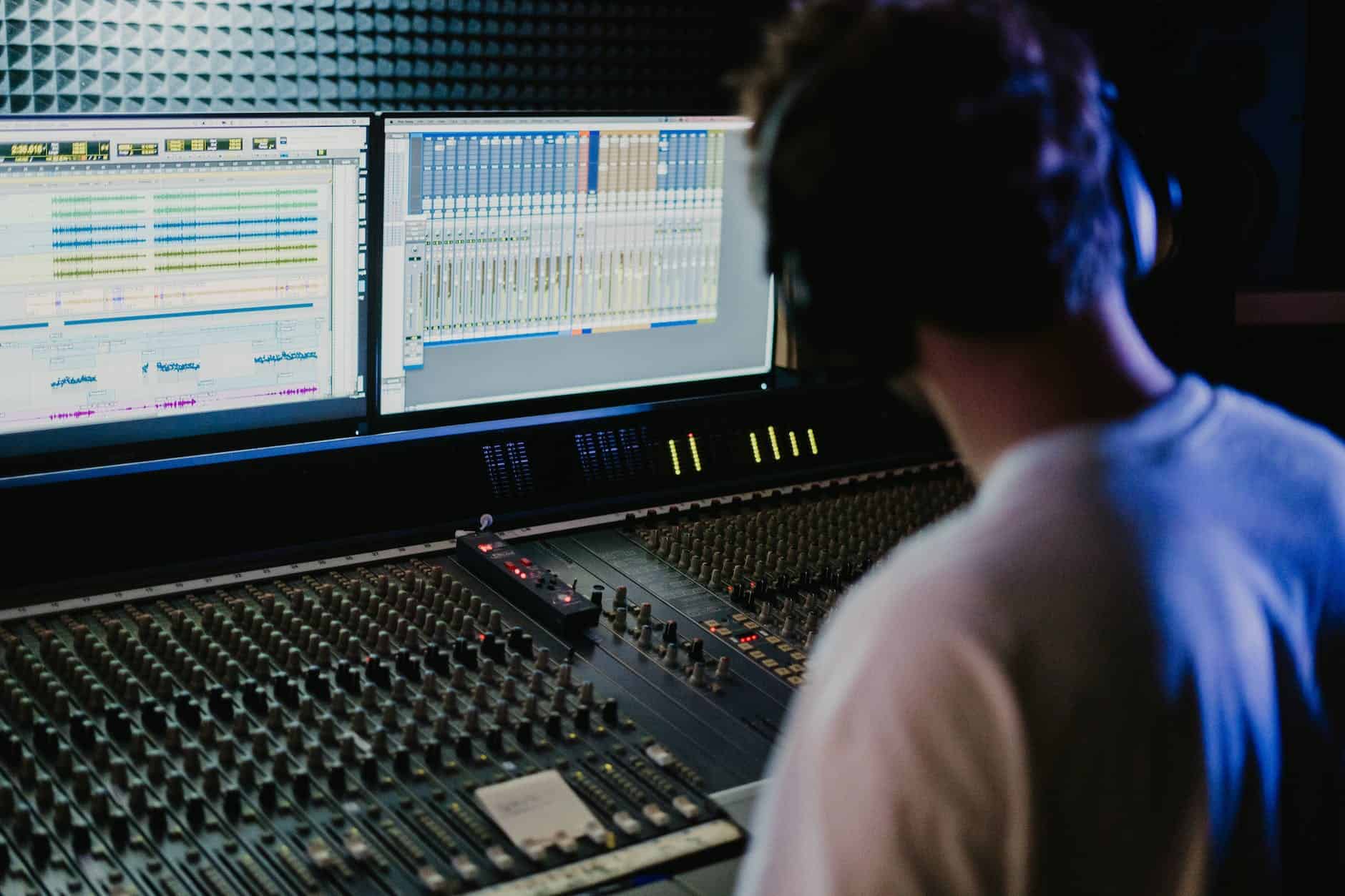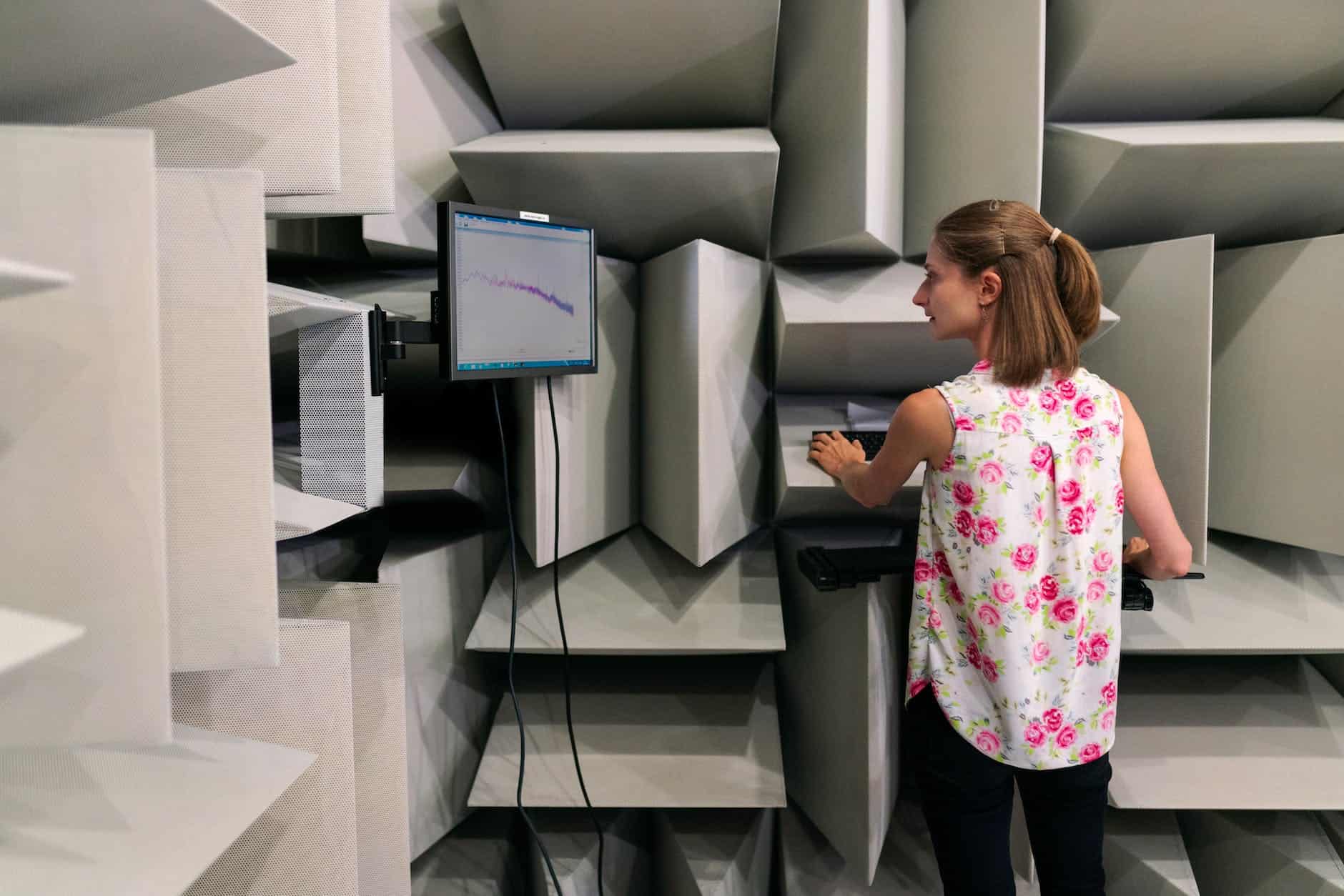Expert Guides
Optimize Your Space with Room Acoustic Treatment

When it comes to creating the perfect sound environment, room acoustics play a vital role. Whether you’re a musician, podcaster, or simply someone who values high-quality audio, understanding and implementing effective acoustic treatment techniques can greatly enhance your space and optimize sound quality.
Room acoustics refer to how sound interacts with the surfaces in a space, such as walls, ceilings, and floors. Factors like room shape, construction materials, and the presence of soundproofing materials can all impact the way sound moves through a room.
To optimize your space for better sound quality, it’s important to consider acoustic treatment for rooms. This involves using soundproofing solutions, such as sound absorption panels and other acoustic treatment products, to reduce echo, minimize unwanted noise, and create a more balanced sound environment.
- Room acoustics are crucial for achieving optimal sound quality in any space.
- Factors like room shape, construction materials, and soundproofing solutions impact sound movement.
- Acoustic treatment products, such as sound absorption panels, can help optimize sound quality and reduce echo.
- Implementing soundproofing techniques improves the overall listening experience.
- Consider room acoustics and use appropriate acoustic treatment techniques to create an enjoyable sound environment.
What Are Room Acoustics?
Room acoustics play a vital role in creating an optimized sound environment. To understand how sound behaves in a room, it’s essential to explore the concept of room acoustics.
Room acoustics refer to the way sound travels through an enclosed space. When sound energy is produced, it emits sound waves that radiate in all directions. These sound waves then interact with the surfaces and objects within the room.
There are two main processes involved in room acoustics: sound absorption and sound reflection. Sound absorption occurs when sound energy is absorbed by the surfaces in the room, reducing its intensity. On the other hand, sound reflection happens when sound waves bounce off surfaces and continue to travel through the space.
Understanding how sound absorption and reflection work is crucial in optimizing room acoustics. By strategically placing sound absorption panels in the room, we can control the intensity and timing of sound reflections, reducing echoes and reverberation. This improves the overall sound quality and makes the space more enjoyable to be in.
In summary, room acoustics refers to how sound energy interacts with the surfaces and objects within an enclosed space. By managing sound absorption and reflection, we can optimize room acoustics and create a desirable sound environment.
What Impacts Room Acoustics?
When it comes to room acoustics, several factors come into play. These factors influence how sound behaves and interacts within a space, ultimately affecting the overall sound quality and experience. By understanding and considering these elements, you can make informed decisions to optimize room acoustics.
Room Shape
The shape of a room plays a crucial role in acoustic performance. Different room shapes can result in varying sound reflections and resonances. For example, rectangular rooms tend to have strong resonances and uneven sound distribution, while irregularly shaped rooms may cause sound to scatter unpredictably.
Room Surfaces
The surfaces within a room, such as the flooring, walls, and furnishings, also impact room acoustics. Hard surfaces, like concrete or tile floors, and bare walls can cause sound to reflect and create echos or reverberations. On the other hand, soft surfaces like carpet, rugs, and curtains absorb sound, reducing reflection and enhancing acoustics.
Ceiling Height and Ceiling Panels
The height of the ceiling affects the way sound moves within a room. Higher ceilings can result in a longer reverberation time, while lower ceilings may cause sound to be absorbed quickly. Additionally, the presence of ceiling panels can further affect sound absorption and diffusion, influencing the overall acoustics of the space.
Construction Materials
The materials used in the construction of a room impact its acoustics. Different materials have varying sound absorption and reflection properties. For example, concrete or brick walls tend to reflect sound, while acoustic panels or foam can absorb sound and improve the acoustics of a space.
| Factors | Impact on Room Acoustics |
|---|---|
| Room Shape | Influences sound reflections and resonances |
| Room Surfaces | Affects sound absorption and reflection |
| Ceiling Height and Ceiling Panels | Influences sound absorption, diffusion, and reverberation time |
| Construction Materials | Affects sound absorption and reflection properties |
By considering the room shape, surfaces, ceiling height, ceiling panels, and construction materials, you can make intentional choices to optimize room acoustics. Whether you’re setting up a home theater, recording studio, or conference room, understanding and addressing these factors can help create an immersive and enjoyable sound environment.
Why is Acoustic Design Important?
Acoustic design plays a vital role in ensuring optimal sound quality and volume levels within a room. By considering the materials and construction methods used, we can create a space that maximizes the benefits of acoustic design, resulting in a more enjoyable and immersive audio experience.
One of the key elements of acoustic design is the choice of construction materials. Materials such as concrete and fiberglass insulation are commonly used for their sound reflection and absorption properties. Concrete can effectively reflect sound, preventing noise from transmitting between different areas. On the other hand, fiberglass insulation can absorb sound, reducing background noise and creating a more peaceful environment.
The reflection and absorption of sound are crucial for controlling the acoustics of a room. Reflection refers to the bouncing of sound off surfaces, while absorption involves the dissipation of sound energy. By strategically placing materials that reflect or absorb sound, we can shape the acoustics of a room to achieve the desired sound quality. Reflection can help amplify desired sounds, while absorption can reduce unwanted noise and echoes.
“Proper acoustic design can enhance communication, decrease stress, reduce background noise, and amplify desired sounds.”
Ignoring acoustic design can have negative consequences for the overall quality of a room. Without proper design considerations, there may be a higher level of noise transmission between spaces, resulting in a distracting or intolerable environment. Additionally, poor acoustic design can lead to an unbalanced sound experience, where certain frequencies are overly amplified or masked by background noise.
Overall, the importance of acoustic design cannot be overstated. By incorporating the principles of sound reflection, absorption, and noise reduction into our design choices, we can create a space that optimizes sound quality and enhances our audio experience.
| Benefits of Acoustic Design | Examples |
|---|---|
| Enhanced sound quality | Clear, crisp audio with accurate reproduction of frequencies |
| Improved communication | Reduced background noise allows for easier conversations |
| Reduced stress | A more peaceful and relaxing environment |
| Noise reduction | Minimized noise transmission between rooms or spaces |
How to Improve Room Acoustics for Your Industry
Different industries have unique acoustic requirements for their spaces. By tailoring acoustic treatments to specific industries, you can create optimal sound environments for various purposes.
Hospitals
In hospitals, maintaining confidentiality and reducing noise levels are crucial. Installing ceiling and wall panels and using door seal kits can significantly improve room acoustics in healthcare facilities.
Recording Studios
Recording studios require specialized acoustic treatment techniques to achieve optimal sound quality. Soundproof curtains, drywall with green glue, and soundproof doors can effectively minimize external noise and create an isolated recording environment.
Schools
Creating a conducive learning environment is essential in schools. By using fabric wall panels and implementing sound-buffering products, schools can enhance room acoustics and minimize distracting noises, allowing students to focus better.
Government Rooms
Government rooms, such as meeting rooms and legislative chambers, often face challenges related to noise pollution. The use of Barrier Decouplers and window inserts can help reduce external noise and ensure a more productive and focused environment.

By understanding the specific acoustic needs of your industry and implementing the right solutions such as ceiling and wall panels, door seal kits, soundproof curtains, or window inserts, you can significantly improve the room acoustics in your space, creating an optimal sound environment for your industry’s requirements.
Optimal Acoustic Treatment Options Within Different Budgets
When it comes to acoustic treatment, there are options available to suit every budget. Whether you’re looking for cost-effective DIY solutions or professional-grade panels, there are choices that can enhance the sound quality of your space without breaking the bank.
DIY Treatment and Room Setup
If you’re on a limited budget, DIY treatments using household items can be surprisingly effective. Utilizing blankets, towels, and curtains to absorb sound can make a noticeable difference in room acoustics, and the best part is that it won’t cost you a dime. Additionally, optimizing your room setup by strategically placing furniture and utilizing bookshelves or other surfaces can help to deflect and absorb sound waves, further improving the overall acoustics.
Homemade Solutions
For a budget under $500, you can make your own acoustic panels and diffusers with materials readily available at your local hardware store. These homemade solutions can be a cost-effective option while still providing noticeable improvements in sound quality. With a little creativity and some DIY know-how, you can create acoustic treatments tailored to your space.
Professional Panels
If you have a higher budget, investing in professional acoustic panels can take your room’s sound quality to the next level. Trusted brands such as GIK Acoustics offer a range of acoustic panels designed to address various acoustic issues. These panels are meticulously crafted using high-quality materials to provide optimal sound absorption and diffusion. GIK Acoustics provides expert advice and guidance to help you choose the right panels for your specific needs.
| Acoustic Treatment Option | Budget Range |
|---|---|
| DIY Treatments | $0 |
| Homemade Acoustic Panels and Diffusers | Under $500 |
| GIK Acoustics Panels | Under $1,000 |
In addition to acoustic panels, software like Sonarworks can provide a trusted reference point for accurate monitoring capabilities. By utilizing these tools and treatments, you can optimize your room’s acoustics and create the best sound experience within your budget.
Investing in acoustic treatment is a worthwhile endeavor, whether you’re a musician, podcaster, or simply someone who values high-quality audio. By considering your budget and exploring the various options available, you can find the optimal acoustic treatment solutions to enhance your space’s sound quality and create a more immersive audio experience.

Expert Advice for Acoustic Optimization
When it comes to optimizing room acoustics, expert advice can make all the difference. An acoustics consultant is a valuable resource who can provide the necessary expertise and guidance to achieve optimal results. They possess the knowledge and experience to analyze the acoustics of your space, develop a customized treatment plan, and offer recommendations for speaker placement, addressing acoustic interference, and optimizing room layout.
One of the key benefits of consulting with an acoustics consultant is their ability to conduct acoustic analysis. By thoroughly assessing the unique characteristics of your room, they can identify areas of concern and recommend effective solutions tailored to your specific needs. This comprehensive analysis allows for targeted treatment strategies that address the specific challenges of your space.
In addition to acoustic analysis, an acoustics consultant can also create a customized room treatment plan. This plan outlines the recommended treatments and their placement within your space. By following this plan, you can target problem areas and strategically implement acoustic treatments for maximum effectiveness.
Speaker placement is another critical aspect that an acoustics consultant can provide expert advice on. The proper positioning of speakers within a room can greatly impact the overall sound quality. Whether you’re setting up a recording studio or a home theater, an acoustics consultant can guide you in positioning your speakers to minimize unwanted reflections and optimize sound dispersion.
Acoustic interference can be a significant challenge in achieving optimal room acoustics. An acoustics consultant can identify potential sources of interference and recommend solutions to mitigate their impact. By addressing acoustic interference, you can create a more immersive listening experience with enhanced clarity and accuracy.
Optimizing the layout of your recording studio is another area where an acoustics consultant can provide valuable insights. They can guide you in designing a studio layout that minimizes the impact of external noise and optimizes the positioning of instruments and equipment for optimal sound capture.
Lastly, an acoustics consultant can offer custom treatment solutions tailored to your specific needs. They understand that each space is unique, with its own set of challenges and requirements. By providing custom treatment solutions, they ensure that your room receives the appropriate treatments to optimize the acoustics and create an ideal sound environment.
Whether you’re building a new recording studio or looking to improve the acoustics of your existing space, consulting with an acoustics consultant is a wise investment. Their expert advice, acoustic analysis, custom treatment solutions, and guidance in speaker placement, acoustic interference, and room layout optimization will ensure that you achieve the best possible results in your quest for superior sound quality.
Achieving the Best Sound Quality for Your Space
At [Brand Name], we understand the importance of sound quality and the role it plays in creating an immersive experience. By optimizing the room acoustics and implementing effective acoustic treatment, you can achieve the best sound quality for your space.
One key aspect of creating a high-quality audio environment is achieving a balanced sound. This means ensuring that all frequencies are accurately represented, allowing you to hear every detail with clarity. With optimized room acoustics, you can eliminate any potential imbalances and enjoy a truly immersive sound experience.
Accurate monitoring capabilities are essential for critical listening and producing professional-grade recordings. By optimizing your room acoustics, you can create an environment where you can trust the sound you hear, allowing you to make precise adjustments and capture the true essence of your audio.
“Optimizing room acoustics provides an immersive experience where every nuance of the sound is faithfully reproduced, resulting in professional-grade recordings and the ability to critically listen with confidence.”
Investing in acoustic treatment and optimizing your space can greatly enhance the overall sound quality. By utilizing sound-absorbing materials, diffusers, and proper placement of acoustic panels, you can minimize unwanted reflections and echoes, resulting in a cleaner and more accurate sound.
To help you visualize the impact of room acoustics, take a look at the table below:
| Without Acoustic Treatment | With Acoustic Treatment |
|---|---|
| Unbalanced sound | Well-balanced sound |
| Inaccurate monitoring | Accurate monitoring |
| Unwanted reflections and echoes | Improved sound clarity |
| Limited sound quality | Enhanced sound quality |
[Brand Name] offers a wide range of acoustic treatment solutions to help you achieve the best sound quality for your space. From high-quality acoustic panels to professional-grade diffusers, our products are designed to optimize room acoustics and create an immersive audio experience.
By implementing effective acoustic treatment and optimizing your room acoustics, you can elevate the sound quality of your space and enjoy a truly immersive audio experience. Trust [Brand Name] to provide the expertise and solutions you need to achieve the best sound possible.
The Importance of Room Acoustic Treatment
Room acoustic treatment is crucial for creating an enhanced audio experience in any space. By implementing effective soundproofing and absorption techniques, you can optimize the acoustics of your room and elevate the quality of sound. Whether you’re setting up a home office, recording studio, or classroom, investing in room acoustic treatment can have a significant impact on your overall audio experience and the optimization of the space.
One of the key benefits of room acoustic treatment is the reduction of unwanted noise. By utilizing soundproofing techniques, such as acoustic panels, baffles, and foam, you can minimize external noise sources that interfere with your listening experience. This allows for a more focused, immersive audio environment, free from distractions and disturbances.
Improved sound quality is another vital aspect of acoustic treatment. By strategically placing acoustic panels and diffusers, you can minimize sound reflections and echoes, resulting in a cleaner, more balanced sound. This is especially crucial in recording studios, where accurate sound reproduction is essential for producing professional-grade recordings and ensuring an accurate mix.
Acoustic treatment also plays a significant role in absorption, allowing for better control over room optimization. Absorption techniques, such as bass traps and acoustic curtains, help to absorb excess low-frequency energy and attenuate reverberations, creating a more controlled and pleasant sound environment. This is particularly important in rooms with poor acoustics, where excessive reverberation can negatively impact the clarity of speech and music.
Whether you’re a musician, podcaster, or avid audiophile, investing in room acoustic treatment can greatly enhance your audio experience. It creates an optimized sound environment that allows you to fully immerse yourself in the music or audio content, capturing every subtle detail with clarity and precision.
“Room acoustic treatment is like fine-tuning your audio system. It allows you to unlock the true potential of your speakers and ensure an accurate and enjoyable listening experience.”
In conclusion, don’t underestimate the importance of room acoustic treatment. It is a critical step in creating an enhanced audio experience, improving sound quality, and optimizing the space for its intended purpose. Whether you’re seeking to create a professional recording environment, a personal home theater, or a productive workspace, investing in acoustic treatment solutions is an essential aspect of creating a space where sound truly comes to life.
Conclusion
In conclusion, room acoustic treatment is essential for creating an optimized sound environment. By taking into account factors such as room shape, surfaces, and materials, and implementing appropriate acoustic treatments, we can greatly improve sound quality, reduce unwanted noise, and enhance the overall listening experience. Whether you’re a musician, podcaster, or simply someone who appreciates high-quality audio, investing in room acoustic treatment is a worthwhile endeavor that can transform your space and optimize sound quality.
With room acoustic treatment, we can achieve a balanced sound environment and accurate monitoring capabilities for critical listening. This allows us to produce professional-grade recordings and enjoy an immersive audio experience where every detail is heard with clarity and precision. By investing in acoustic treatment and optimizing the acoustics of your space, you can create a truly enjoyable and immersive audio environment.
Don’t underestimate the importance of room acoustic treatment. It is a crucial element in enhancing the audio experience and achieving optimal sound quality. By reducing unwanted noise, implementing soundproofing techniques, and optimizing room acoustics, you can create a space that is optimized for its intended purpose. Whether you’re setting up a home office, recording studio, or classroom, room acoustic treatment is a valuable investment that can greatly enhance the sound quality and overall enjoyment of your space.
Room acoustic treatment refers to techniques and solutions used to optimize the acoustics of a space, including soundproofing and sound absorption. It helps improve sound quality and create a more enjoyable listening environment.
Room acoustics refer to the way sound travels through an enclosed space. It involves how sound energy interacts with the surfaces in a room, either through absorption or reflection.
Several factors impact room acoustics, including the shape of the room, the surfaces within it (such as carpet, rugs, furnishings, and walls), the height of the ceiling, the presence of ceiling panels, and the construction materials used.
Acoustic design is important because it impacts both the sound quality and the volume levels within a room. Proper acoustic design can enhance communication, decrease stress, reduce background noise, and amplify desired sounds. Different industries have unique acoustic requirements. Hospitals can benefit from the installation of ceiling and wall panels and the use of door seal kits. Recording studios require specialized techniques such as soundproof curtains, drywall with green glue, and soundproof doors. Schools can enhance room acoustics with fabric wall panels and sound-buffering products. Government rooms can benefit from Barrier Decouplers and window inserts to reduce noise pollution.
Acoustic treatment options vary depending on the budget. DIY treatments using household items can be effective for those with limited budgets. Homemade solutions, making your own acoustic panels and diffusers, can be cost-effective options. There are also professional acoustic panels and products available at different price points.
Obtaining expert advice from an acoustics consultant can be invaluable in optimizing room acoustics. They can provide acoustic analysis, create a customized room treatment plan, and offer recommendations for speaker placement, addressing acoustic interference, and optimizing room layout.
By implementing effective acoustic treatment and optimizing the room acoustics, you can achieve the best sound quality for your space. This includes creating a balanced sound environment, ensuring accurate monitoring capabilities, and producing professional-grade recordings.
Room acoustic treatment is essential in enhancing the audio experience in any space. It involves techniques such as soundproofing and absorption to optimize the room acoustics, reduce unwanted noise, and improve sound quality. Room acoustic treatment plays a crucial role in creating an optimized sound environment. By considering factors such as room shape, surfaces, and materials, and implementing appropriate acoustic treatments, you can improve sound quality, reduce unwanted noise, and create a more enjoyable listening experience.
FAQ
What is room acoustic treatment?
What are room acoustics?
What factors impact room acoustics?
Why is acoustic design important?
How can room acoustics be improved for different industries?
What are some acoustic treatment options within different budgets?
Why should I seek expert advice for room acoustic optimization?
How can I achieve the best sound quality for my space?
Why is room acoustic treatment important?
What is the importance of room acoustic treatment?
AI Generator
Ownership Battle in the Age of AI-Generated Music

The emergence of artificial intelligence in music production has ushered in a new era of innovation. However, it has also sparked debates over ownership rights. As AI-generated music becomes more common, concerns about who owns these creations are brought to light.
This article delves into the legal battles and ethical debates surrounding AI-generated music ownership.
Defining Ownership in AI-Generated Music
In a traditional sense, determining the owner of the copyrighted material is straightforward. However, with AI-generated content, the situation becomes more complex.

Is the creator of the algorithm that generated the music the owner? Is it the person who trained the algorithm? Is it possible to claim ownership over something not directly created by human hands?
Grimes’s Controversial Tweet: A Case Study
Grimes’s tweet about allowing her voice to be used in AI-generated music exemplifies this issue. She said she would sell her digital soul for $10 million, granting an AI company permission to use her voice as they wished. The tweet sparked controversy, with some seeing it as selling out and others viewing it as a clever move.
Legal Battles and Intellectual Property
Ownership rights of AI-generated music are just starting to be tested in courts. In 2018, Sony won a landmark case against musician Kevin Parks Jr., who claimed he had created songs using Sony’s software without permission or compensation. The court ruled in favor of Sony since their software was used in creating Parks’ songs.
This ruling raises questions about whether algorithms can be considered intellectual property or merely tools used by creators. If algorithms are deemed intellectual property, there may be issues surrounding their licensing for commercial use.
Record Labels and the Changing Dynamics
As record labels adapt to the rise of AI-generated content, they, too, must confront ownership rights issues. Record labels have historically owned much of the copyright associated with artists’ work; however, this dynamic may change as more artists turn to AI-generated music.
If an artist uses an AI program to create a piece of music, who owns the rights to that work? Is it the artist or the creator of the algorithm that generated it?
Implications for Streaming Platforms
The rise of AI-generated music also impacts streaming platforms like Spotify and Apple Music. These platforms have already faced criticism for their low royalty payouts to artists, and if AI-generated content becomes more prevalent, this issue may only worsen.
Additionally, as record labels lose some control over ownership rights, they may push for higher payouts from these streaming services.
Public Domain and AI-Generated Music
The implications of AI-generated music on the public domain are worth considering. AI algorithms often use existing music data to create new compositions, raising questions about whether AI-generated music should be considered part of the public domain or if new legal frameworks are needed to protect both original creators and AI developers.
When an AI algorithm generates music based on existing works, it can be difficult to determine if the resulting composition is a derivative work or an entirely new creation. If AI-generated music is considered part of the public domain, it may limit the rights of original creators whose work was used as input. On the other hand, if AI-generated music is granted copyright protection, it could potentially stifle creativity and limit access to cultural works.
Moral Rights and AI-Generated Music
The concept of moral rights is particularly relevant in the context of AI-generated music. Moral rights protect an artist’s right to be recognized as the creator of their work and to preserve the integrity of their creations. It is important to discuss how moral rights might apply to AI-generated music and the potential challenges that may arise.
In the case of AI-generated music, it can be difficult to determine who should be recognized as the creator: the original artist whose work was used as input, the developer of the AI algorithm, or both. Additionally, AI-generated music may inadvertently modify or distort the original work, potentially violating the moral rights of the original creator.
AI-Generated Music and Fair Use
The concept of fair use plays a significant role in the context of AI-generated music. Fair use is a legal doctrine that allows for the limited use of copyrighted material without requiring permission from the rights holder. It is important to discuss whether AI-generated music, which often relies on existing music data, can be considered fair use and the potential legal implications that may arise.
When AI algorithms use existing music as input, they may be seen as transformative, creating new works based on the original material. However, the extent to which AI-generated music can be considered fair use is not yet clearly defined in the law, and it may vary depending on the degree of transformation and the potential market impact on the original work.
In conclusion, addressing the additional topics of public domain, moral rights, and fair use in AI-generated music contributes to a more comprehensive understanding of the various legal and ethical issues surrounding this emerging technology. As AI-generated music becomes more prevalent, it is crucial for legal frameworks and industry practices to adapt in order to balance the rights of creators, AI developers, and the public interest.
The Future of Ownership Rights
In conclusion, ownership rights in the era of AI-generated music are uncertain at best. As more legal battles arise and ethical debates continue, it is clear that traditional copyright laws will need to adapt to keep up with technological advancements.
The struggle for ownership is just beginning, but it will undoubtedly shape the future of the music industry for years to come.
AI Generator
The Influence of Artificial Intelligence on The Creation of Music

A New Era of Creativity and Expression
Music has always been a strong reflection of human innovation and emotions. Throughout history, our voices and musical instruments have played a crucial role in expressing our feelings, telling stories, and building relationships with others. As technology has advanced, our ways of creating music have also progressed.
Modern musicians now have access to various tools, enabling them to manipulate sound in unimaginable ways. Synthesizers can emulate virtually any sound, while digital audio workstations facilitate precise editing and manipulation of recorded tracks. And now, the rise of artificial intelligence (AI) offers musicians even more possibilities for music creation.
AI Applications in the Music Industry
AI is being utilized in multiple ways within the music industry. One popular application is generating original compositions based on existing musical data sets. By analyzing millions of songs across genres and periods, AI algorithms can identify patterns and generate new melodies or chord progressions that fit within those patterns.

Another application involves using AI to enhance existing performances or recordings. For instance, software like iZotope’s RX can isolate individual instrumental tracks from a mix and remove unwanted noise or artifacts without impacting the rest of the recording.
Unintended Consequences and Concerns
However, as with any emerging technology, unintended consequences arise from using AI in music creation. One worry is that AI-generated music might lack the emotional depth and nuance that human performance offers. While an algorithm can create technically proficient melodies or chord progressions, it may not capture the same sense of emotion or passion found in a live performance.
Another concern revolves around ownership rights of AI-generated music. If an algorithm generates an original composition based on data sets owned by multiple parties (such as record labels or streaming platforms), who has the rights to that composition? This question has already sparked legal battles between artists collaborating with AI algorithms and those claiming ownership over their contributions.
Harnessing AI for Collaboration and Growth
Many musicians and industry professionals see AI as an opportunity for collaboration and growth. AI can be a creative assistant, inspiring artists, helping them overcome writer’s block, or even offering suggestions to improve their compositions. As AI technology continues to evolve, its ability to learn from and adapt to a musician’s style will improve, further enhancing the creative process.
AI in Music Education and Talent Discovery
AI also has the potential to revolutionize music education and talent discovery. With AI-powered music learning apps and platforms, students can receive personalized instruction based on their skill level and learning style. Furthermore, AI can analyze and identify undiscovered talent by evaluating their performances and predicting their potential for success.

Addressing Ethical Considerations and Regulations
To ensure the responsible integration of AI into the music industry, it is essential to address ethical considerations and establish regulations. For instance, guidelines should be set to ensure that AI-generated compositions do not infringe on existing copyrights or that AI technology is not used maliciously to plagiarize or manipulate the work of others.
Additionally, as AI-generated music becomes more prevalent, it is crucial to develop clear standards for crediting the contributions of both human artists and AI algorithms to a given work. This will help to prevent legal disputes and foster a fair and transparent environment for all parties involved.
Ethical Considerations in AI-Generated Music
As AI-generated music becomes increasingly widespread, various ethical concerns emerge. Some of these concerns include the potential for AI-generated music to contribute to cultural appropriation, the dilution of traditional music styles, or the homogenization of music in general.
Cultural Appropriation
Cultural appropriation occurs when elements of one culture are adopted or used by members of another culture, often in a way that is disrespectful or exploitative.

AI-generated music, which often relies on large datasets of existing music, might inadvertently incorporate elements of various cultures without giving proper credit or understanding the cultural context. This can result in the misrepresentation or trivialization of the original culture and may lead to further marginalization of underrepresented communities.
Dilution of Traditional Music Styles
AI-generated music algorithms are often designed to identify popular patterns and trends within the music they analyze.
As a result, the output may lean heavily toward mainstream or widely-accepted styles, which can dilute traditional or less-popular music styles. Over time, this may result in a decline in the diversity of music genres and a loss of unique cultural expressions and heritage.
Homogenization of Music
The widespread use of AI-generated music could also contribute to the homogenization of music, as algorithms tend to create compositions based on patterns and trends found in existing data. This may result in technically proficient music lacking the distinctiveness and creativity found in human-generated compositions.
As AI-generated music becomes more prevalent, there is a risk that the rich tapestry of diverse musical styles and influences may be reduced to a more uniform, less imaginative landscape.
In conclusion, while AI-generated music offers exciting opportunities for innovation and new forms of creativity, addressing and considering the ethical implications of its widespread use is crucial. It is essential to develop ways to preserve cultural diversity and respect the heritage of various music styles while embracing the potential of AI in music creation.
Embracing the AI-Infused Future of Music
The increasing influence of AI in the music industry offers an exciting new frontier for creativity, collaboration, and innovation. By addressing the potential concerns and working together to create ethical guidelines and regulations, musicians, industry professionals, and AI developers can ensure that the integration of AI into the music landscape is both responsible and beneficial.
As we embrace this AI-infused future, we can look forward to new and innovative ways to create and enjoy music, while also remaining mindful of the potential pitfalls and challenges that come with any technological advancement. With the right approach, the future of music and AI has the potential to be a harmonious and groundbreaking partnership.
Despite these concerns, it’s undeniable that AI is revolutionizing the music industry in thrilling ways. It enables new forms of creativity and experimentation while also presenting unique challenges for artists and record labels alike. As we continue to navigate this new era of music creation, it will be fascinating to see how these unintended consequences evolve.
Podcast
Bridging the Gap: Harnessing the Power of Podcasts and Videos to Connect Communities with Vital Services

Podcasts and Videos in Community Services
Community support services are essential for helping those in need, but many individuals are unaware of the resources available to them. This is where podcasts and videos play a vital role as powerful tools for educating and engaging community members.
By creating audio and visual content that highlights the impact of community services, organizations can bridge the gap between service providers and the people they serve.
In this blog post, we will explore the various benefits of incorporating podcasts and videos into community services strategies and best practices for creating engaging content.
The Role of Podcasts and Videos in Strengthening Community Services
Podcasts and videos are a powerful way to communicate with community members and inform them of available services. Through audio and visual content, community service organizations can educate and engage their audience.
Podcasts and videos can help bridge the gap between community members and service providers, increasing accessibility and awareness of resources. Creating content that highlights the impact of community services can inspire others to get involved and support the cause.
Podcasts and videos can also provide a platform to share personal stories and experiences, helping to break down stigma and create a sense of community.
How Podcasts and Videos Can Help Improve Access to Community Resources
Podcasts and videos can provide a medium for sharing information about important community resources in an engaging and accessible way. This is particularly important for individuals who may not have access to traditional written materials or may have language barriers. Here are some ways in which podcasts and videos can improve the accessibility of community resources:
- Breaking down language barriers: Audio and visual content can help reach individuals who may speak a different language or have limited literacy skills. By providing information in a format that doesn’t rely on reading, podcasts and videos can help ensure that more members of the community are able to access important resources.
- Providing updates: Podcasts and videos can be used to provide updates on changes to community resources such as hours of operation, new programs, or changes to eligibility criteria.
- Encouraging action: Creating content that encourages community members to take action, such as accessing resources or volunteering, can help improve utilization of services. By highlighting the benefits of certain resources, podcasts and videos can help inspire individuals to take advantage of them.
- Showcasing impact: Podcasts and videos can showcase the impact of community resources through personal stories and testimonials, further highlighting their value. By sharing stories of those who have benefited from the resources, community service organizations can emphasize the importance of accessibility to community resources.
In short, podcasts and videos can play a crucial role in improving access to community resources by breaking down language barriers, providing updates, encouraging action, and showcasing impact.

Community service organizations should consider incorporating these mediums into their outreach efforts to help ensure that important resources are accessible to all members of the community.
The Benefits of Using Audio and Video Content in Community Outreach Programs
Using audio and visual content can have many benefits for community service organizations looking to reach a wider audience and strengthen their outreach efforts. Here are some of the key advantages:
- Engaging format: Audio and video content can be more engaging and memorable than written materials, helping to capture the attention of community members and inspire them to take action.
- Accessibility: Audio and visual content can help organizations reach individuals who may not have access to traditional written materials or who speak a different language.
- Personal connection: Incorporating personal stories and testimonials can help community members feel more connected to the cause and motivated to get involved.
- Establishing expertise: Creating regular content, such as a podcast or video series, can help organizations establish themselves as thought leaders in their field and build a following.
- Collaboration: Podcasts and videos can provide a platform for collaboration and partnerships with other organizations, further strengthening the impact of community outreach programs.
Overall, incorporating audio and video content into community outreach programs can help organizations better connect with their audience, improve access to important resources, and build a stronger, more engaged community.
Using Podcasts and Videos to Enhance Volunteer Recruitment in Community Services
Volunteers are a crucial part of any community service organization. However, finding and recruiting volunteers can be a challenge. Podcasts and videos can be an effective way to enhance volunteer recruitment efforts.
Creating Content that Highlights the Impact of Volunteer Work
One of the most powerful ways to inspire people to volunteer is by showcasing the impact that their work can have. Creating content that tells the stories of volunteers and the impact they’ve had can be a powerful recruitment tool.
Consider producing videos or podcasts that feature interviews with volunteers, sharing their experiences and the change they are making in their communities. Highlighting impactful volunteer projects that have made a difference in the community can also be a great way to draw attention to volunteer opportunities.
Providing Information on Volunteer Opportunities
Podcasts and videos can also be used to provide information about volunteer opportunities. Creating a series of short videos or podcast episodes that highlight different volunteer roles and the skills needed to excel in them can be a great way to engage potential volunteers.
It can also be helpful to include information on the benefits of volunteering, such as gaining new skills, meeting new people, and making a positive impact in the community. By sharing this information in an engaging and accessible format, community service organizations can attract more volunteers and build a strong team of supporters.
Using Storytelling to Encourage Volunteer Action
Storytelling can be a powerful tool for encouraging people to take action. By sharing stories of the impact that volunteers have had in the community, organizations can inspire others to get involved.
Consider using video or audio content to showcase the experiences of volunteers and highlight the difference they have made. Encouraging existing volunteers to share their stories and experiences can also be an effective way to generate interest in volunteering and attract new supporters.
By incorporating podcasts and videos into their outreach strategies, community service organizations can enhance volunteer recruitment efforts and attract more supporters. Whether through highlighting the impact of volunteer work, providing information on volunteer opportunities, or using storytelling to encourage volunteer action, audio and visual content can be a powerful way to engage and inspire others to get involved in their communities.
Creating Engaging Video and Audio Content for Community Service Organizations
When it comes to creating content for community service organizations, it’s important to consider the audience and their preferences for consuming information. Here are some tips for creating engaging video and audio content:
- Incorporate personal stories and testimonials: By sharing personal stories of how the organization has made a difference in people’s lives, you can make the content more relatable and engaging for viewers and listeners. Testimonials can also help build credibility for the organization.
- Use visual aids: Visual aids, such as infographics, images, or animations, can help simplify complex information and make it more accessible. Consider using visual aids to break up the content and emphasize important points.
- Create a consistent style and format: Creating a consistent style and format can help build a recognizable brand and increase engagement with regular viewers and listeners. Consider using the same intro and outro music, or using the same colors and fonts throughout your content.
- Experiment with different types of content: To keep your audience engaged, consider experimenting with different types of content, such as short videos, interviews, or animations. By mixing up the format, you can keep your content fresh and interesting.
By following these tips, you can create engaging video and audio content that will help your organization connect with your audience and increase awareness of your services.
Best Practices for Incorporating Podcasts and Videos into your Community Services Strategy
Identify clear goals and objectives
Before incorporating podcasts and videos into your community services strategy, it’s important to identify clear goals and objectives. Consider what you hope to achieve through this type of content and the audience you want to reach. This will help guide your content creation and ensure that your efforts are aligned with your overall strategy.
Invest in high quality equipment and editing software
Investing in high quality equipment and editing software is essential to ensure that your content is professional and engaging. This doesn’t mean that you have to break the bank, but it’s important to have equipment that can produce high quality audio and video content.
Designate a team or individual responsible for content creation
To ensure that your content is published on a consistent basis, designate a team or individual responsible for content creation. This person should have experience with audio and video production, as well as a strong understanding of your organization’s mission and goals.
Engage with the audience through social media and other channels
Engaging with your audience through social media and other channels is key to building a following and encouraging feedback and participation. Monitor comments and respond to questions or concerns promptly to create a sense of community and encourage ongoing engagement.
Measure impact through metrics
Finally, measure the impact of your podcasts and videos through metrics such as downloads, views, and engagement to continuously improve and refine your strategy. This will help you identify what’s working and what’s not, and make data-driven decisions on how to improve your content and reach your goals.
Note: Remember to always prioritize the needs and preferences of your audience when creating content for your community services strategy. By understanding what they want and need, you can create content that resonates with them and helps build a stronger connection between your organization and the community.
Conclusion
In conclusion, podcasts and videos can be powerful tools for community service organizations to communicate with their audience and share important information about available resources. By creating engaging and informative content, these organizations can reach a wider audience and inspire individuals to get involved and support their cause. Incorporating personal stories, testimonials, and visual aids can help create a sense of community and build brand recognition.
Best practices include identifying clear goals, investing in quality equipment and software, designating a team or individual for content creation, engaging with the audience, and measuring impact for continuous improvement.
Using podcasts and videos, community service organizations can strengthen their outreach efforts and make a meaningful impact on their community.
-

 Vetted2 months ago
Vetted2 months ago11 Best Gore Websites to Explore the Darker Side of the Internet
-

 Music Theory2 weeks ago
Music Theory2 weeks agoUnlocking Nature’s Harmony: The Power of 432 Hz Frequency in Sound & Music for Enhanced Living and Well-Being
-

 Vetted1 month ago
Vetted1 month ago15 Best Commercial Vacuum Cleaners for Heavy-Duty Cleaning Jobs
-

 Vetted2 months ago
Vetted2 months ago15 Best Essential Oils Brands to Elevate Your Aromatherapy Experience
-

 Sound Design2 weeks ago
Sound Design2 weeks agoWhat Is the Difference Between a Sound Engineer and A Sound Designer?
-

 Native Instruments Kontakt2 weeks ago
Native Instruments Kontakt2 weeks agoVOCAL AI – Animated Intelligence: The Ultimate Vocal Playground
-

 Sound Design2 weeks ago
Sound Design2 weeks agoWhy Sound Engineer
-

 Vetted2 months ago
Vetted2 months ago15 Best Concrete Sealers for Ultimate Protection and Longevity








